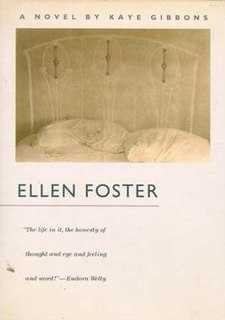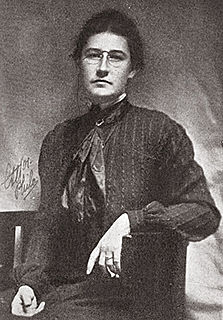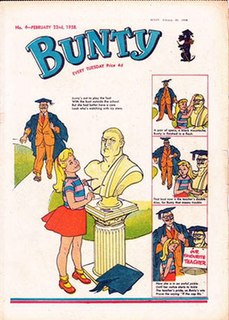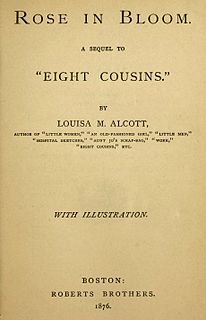Plot summary
The story tells of Elizabeth Ann, a 9-year-old orphan girl who goes from a sheltered existence with her father's aunt Harriet and cousin Frances in the city, to living on a Vermont farm with her mother's family, the Putneys, whose child-rearing practices had always seemed suspect to Harriet and her daughter. In her new rural life, Elizabeth Ann comes to be nicknamed "Betsy," and to find that many activities that Frances had always thought too demanding for a little girl are considered, by the Putney family, routine activities for a child: walking to school alone, cooking, and having household duties to perform.
The child thrives in her new environment, learning to make butter, boil maple syrup, and tend the animals. [1] She also loves to read to herself and to her family. When Frances announces she is to be married and has come to "save" Elizabeth Ann from the dreaded Putney cousins, she is amazed to discover that the little girl is quite content to stay. The story ends after Frances has returned home, with Betsy, her aunt Abigail, uncle Henry, and cousin Ann sitting quietly and happily around the fireplace enjoying the knowledge they will now be a family for good.

Little Women is a coming-of-age novel written by American novelist Louisa May Alcott (1832–1888).

Frances Eliza Hodgson Burnett was an Anglo-American novelist and playwright. She is best known for the three children's novels Little Lord Fauntleroy, A Little Princess (1905), and The Secret Garden (1911).

Harriet Elisabeth Beecher Stowe was an American author and abolitionist. She came from the Beecher family, a religious family, and became best known for her novel Uncle Tom's Cabin (1852), which depicts the harsh conditions experienced by enslaved African Americans. The book reached an audience of millions as a novel and play, and became influential in the United States and in Great Britain, energizing anti-slavery forces in the American North, while provoking widespread anger in the South. Stowe wrote 30 books, including novels, three travel memoirs, and collections of articles and letters. She was influential both for her writings and for her public stances and debates on social issues of the day.

Dorothy Canfield Fisher was an educational reformer, social activist, and best-selling American author in the early 20th century. She strongly supported women's rights, racial equality, and lifelong education. Eleanor Roosevelt named her one of the ten most influential women in the United States. In addition to bringing the Montessori method of child-rearing to the U.S., she presided over the country's first adult education program and shaped literary tastes by serving as a member of the Book of the Month Club selection committee from 1925 to 1951.

Ellen Foster is a 1987 novel by American novelist Kaye Gibbons. It was a selection of Oprah's Book Club in October 1997.

Harriet Elizabeth Prescott Spofford was an American writer of novels, poems and detective stories. One of the United States's most widely-published authors, her career spanned more than six decades and included many literary genres, such as short stories, poems, novels, literary criticism, biographies, and memoirs. She also wrote articles on household decorative art and travel as well as children's literature.

Florence Henrietta Darwin, Lady Darwin, was an English playwright.

What Katy Did is an 1872 children's book written by Sarah Chauncey Woolsey under her pen name "Susan Coolidge". It follows the adventures of a twelve-year-old American girl, Katy Carr, and her family who live in the fictional lakeside Ohio town of Burnet in the 1860s. Katy is a tall untidy tomboy, forever getting into scrapes but wishing to be beautiful and beloved. When a terrible accident makes her an invalid, her illness and four-year recovery gradually teach her to be as good and kind as she has always wanted.

Betsy-Tacy (1940) is the first volume in the Betsy-Tacy series by Maud Hart Lovelace.

Isabella Macdonald Alden was an American author. Her best known works were: Four Girls at Chautauqua, Chautauqua Girls at Home, Tip Lewis and his Lamp, Three People, Links in Rebecca's Life, Julia Reid, Ruth Erskine's Crosses, The King's Daughter, The Browning Boys, From Different Standpoints, Mrs. Harry Harper's Awakening, The Measure, and Spun from Fact.

Jessie Willcox Smith was an American illustrator during the Golden Age of American illustration. She was considered "one of the greatest pure illustrators". A contributor to books and magazines during the late 19th and early 20th centuries, Smith illustrated stories and articles for clients such as Century, Collier's, Leslie's Weekly, Harper's, McClure's, Scribners, and the Ladies' Home Journal. She had an ongoing relationship with Good Housekeeping, which included a long-running Mother Goose series of illustrations and also the creation of all of the Good Housekeeping covers from December 1917 to 1933. Among the more than 60 books that Smith illustrated were Louisa May Alcott's Little Women and An Old-Fashioned Girl, Henry Wadsworth Longfellow's Evangeline, and Robert Louis Stevenson's A Child's Garden of Verses.

How I Live Now is a novel by Meg Rosoff, first published in 2004. It received generally positive reviews and won the British Guardian Children's Fiction Prize and the American Printz Award for young-adult literature.

Eight Cousins, or The Aunt-Hill was published in 1875 by American novelist Louisa May Alcott. It is the story of Rose Campbell, a lonely and sickly girl who has been recently orphaned and must now reside with her maiden great aunts, who are the matriarchs of her wealthy Boston family. When Rose's guardian, Uncle Alec, returns from abroad, he takes over her care. Through his unorthodox theories about child-rearing, she becomes happier and healthier while finding her place in her family of seven boy cousins and numerous aunts and uncles. She also makes friends with Phebe, her aunts' young housemaid, whose cheerful attitude in the face of poverty helps Rose to understand and value her own good fortune.

The House in Paris is Elizabeth Bowen's fifth novel. It is set in France and Great Britain following World War I, and its action takes place on a single February day in a house in Paris. In that house, two young children—Henrietta and Leopold—await the next legs of their respective journeys: Henrietta is passing through on her way to meet her grandmother, while Leopold is waiting to meet his mother for the first time. The first and third sections of the novel, both called "The Present," detail what happens in the house throughout the day. The middle section of the book is an imagined chronicle of part of the life of Leopold's mother, Karen Michaelis, revealing the background to the events that occur in Mme Fisher's home on the day.

"Prelude" is a short story by Katherine Mansfield. It was first published by the Hogarth Press in July 1918, after Virginia Woolf encouraged her to finish the story. Mansfield had begun writing "Prelude" in the midst of a love affair she had in Paris in 1915. It was reprinted in Bliss and Other Stories (1920). The story was a compressed and subtler version of a longer work The Aloe, which was later published posthumously in full.

Bunty was a British comic for girls published by D. C. Thomson & Co. from 1958 to 2001. It consisted of a collection of many small strips, the stories typically being three to five pages long. In contrast to earlier and contemporary comics, it was aimed primarily at working-class readers under the age of 14, and contained mostly fictional stories. Well-known regular strips from Bunty include The Four Marys, Bunty — A Girl Like You, Moira Kent, Lorna Drake, Luv, Lisa, The Comp, and Penny's Place.

Rose in Bloom is a novel by Louisa May Alcott published in 1876. It depicts the story of a nineteenth-century girl, Rose Campbell, finding her way in society. It is Alcott's sequel to Eight Cousins.
Marion Dane Bauer is an American children's author.

Frances Tiernan was an American author who wrote more than 50 novels, most notably The Land of the Sky. Reared as a Roman Catholic, she grew up in the Southern United States.

Georgiana Dorothy Howard, Countess of Carlisle was a British noblewoman. She was born after nine years of childless marriage between William Cavendish, 5th Duke of Devonshire, and his wife, Lady Georgiana Spencer, the political hostess and socialite. As such, she was a member of one of the country's grandest and richest families.



















